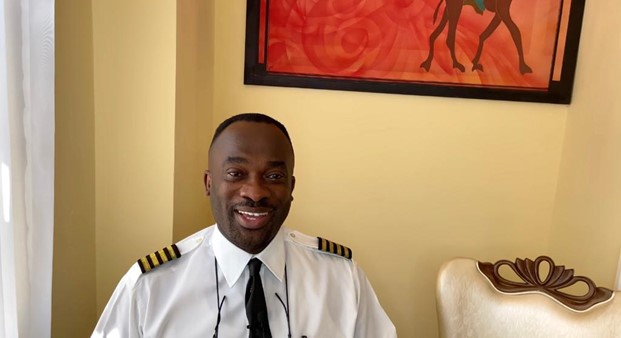Captain Victor Kwesi Amoah, an aviation enthusiast, and motivator once again navigates us through the aero genesis, nature, and scope of the multi-trillion aviation Industry.
The following are questions and answers during an interaction with Captain Amoah, and B&FT…
Speaking of aviation what comes to mind?
The word aviation comes from the Latin word Avis; which means bird. Many decades ago, man saw the flight of a bird, and decided to invent an object to depict a bird flying.
Aviation is the study of activity being Science, Business or Technology with the Operation of flying machine. You said man was fascinated by birds flying and decided to invent a replica; how far did he go? To understand how far he went there is the need to acknowledge the First four eras
in aviation history. Those are; Pre-17th December, 1903, 17th December, 1903 itself, The Decade of the Aero-dare Devils between 1904, and 1914, and the era of the Post World War I during the Pre-17th December, 1903 era, the Wright Brothers, and other inventors invented devices that were more dependent on free air to stay afloat. For example, air balloons, para gliding devices, and others.
Passenger flight was not part of the concept of dreams in that era of pre-17th December, 1903.
The pre-17th December, 1903 saw the Wright Brothers who were bicycle repairers, out of sighting a bird flight attempted, to invent a device that could fly like a bird.
In that era the Wright Brothers felt the device was too laborious to fly. Flying was not enjoyable, because, the devices depended on air to stay afloat. They then decided to invent self-motorised flight. That is, light that got airborne, stayed afloat, descended, and landed under its own power with the help of a specially designed wing, and an engine.
The 17th December, 1903 Era
On a cold and windy Thursday morning at Kitty Hawk in North Carolina, The Wright Brothers, Wilbur, and Orville scheduled their test of their SELF –MOTORIZED flight on their aircraft named the FLYER ONE
Their first experiment saw their first airlifted device crash land after 12 seconds and 120 feet of air travel.
Self-Motorised flights are most of the aircraft operation we see at Airports today, where through a special design of wing shape and an engine enable flights to take off, stay afloat, descend and land under its own power.
They were not satisfied with such feat in terms of time, speed, and height. So, they attempted an improvement, and on the second, third, and fourth attempt of a flight time of 59 seconds.
All the flight tests by Flyer One attracted enthusiastic crowd, courting the competition in the flight invention, after media reports had gone viral. Not satisfied with the device they parked it at a hangar and headed home for Christmas.
No sooner had the Wright Brothers returned in the New Year of January, 1904 than the floodgates of competition began in the invention of flight devices on the heels of media reports about the launch of FLYER ONE on 17th December 1903.
The Competitors being Sports enthusiasts, adrenaline junkies and engineers, had the intention to design aircraft that was to out-perform the Wright Brothers’ FLYER ONE in terms of speed, altitude and distance. That era between January 1904 and the First world war in 1914, was popularly known as the Era of the Aero dare devils. It is interesting to note that the Wright Brothers were part of the Aero dare-devils, because, they wanted to break their own records of 59 seconds on that 17th December, 1903.
So many successes were chalked through successful long distance breaking records, Altitude records, Air shows and other public displays sponsored by business men and the daily mail newspaper of England and that attracted the attention of the military who were then operating only on land, and sea. The military intended to use the aircraft for reconnaissance purposes. More on this!
Through some bitter-sweet moments in that era, the military were fully convinced to use the Aircraft for both reconnaissance and Air Bombing operations and got into contracts with the wright brothers and other successful Aero dare-devils to manufacture aircraft. By the beginning of the First world war, twelve thousand (12,000) Aircraft were procured for the war.
The Post World War I cannot be skipped when the enviable history of aviation is mentioned.
The Post World War one era saw Aircraft that survived in that 5-year war, park idle and that led to the idea of using them for air mail services, and a bit of cargo in America. Later, the idea of flying passengers also came into being.
That saw KLM airline in 1919, and British Airways then Imperial Airways in 1924 came into operation.
From that time on nations began to set up airlines. It started with airmail, then passenger services, and with time moved into freight services.
The post-World War I era also led to various conferences to discuss and ratify international Air regulations with the prime objective of ensuring uniformity in Air operations, both on a safety, and business level, across the Globe. More on this in future articles.
It is interesting to note, that, when dealing with how far man went with the invention those were the first four eras to consider.
What is the nature, and scope of the industry? The industry has four divisions namely; Aerospace that deals with the designing, and building of aircraft. For example, Boeing, Airbus, Bombadier, and others. Air Navigation services is to safely arrive, and depart aircraft or to ensure safe navigation of flight between Airports using, runways, lighting, navigational aids, air traffic services, and to mention just a few.
Airline Services is in the Business of providing safe air travel between airports to clients, and cargo, for a fee.
General Aviation are components of aviation businesses that support the entire industry such as maintenance, training schools, hotels, travel agencies, and catering just to mention a few.










